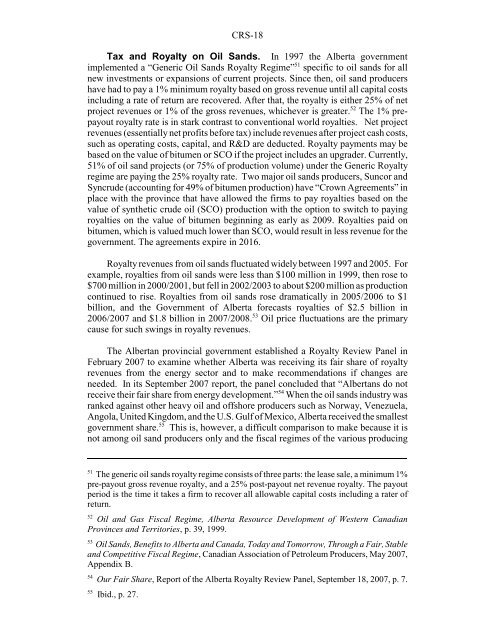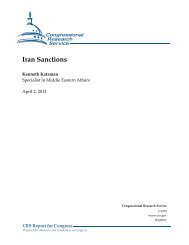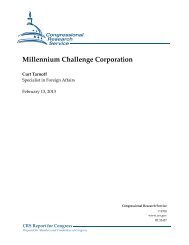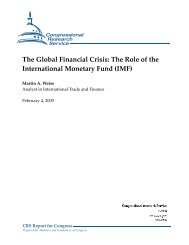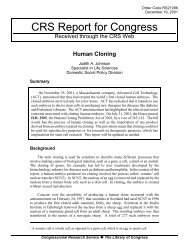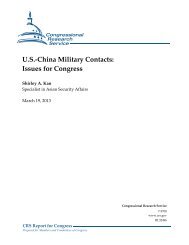North American Oil Sands: History of ... - The Air University
North American Oil Sands: History of ... - The Air University
North American Oil Sands: History of ... - The Air University
You also want an ePaper? Increase the reach of your titles
YUMPU automatically turns print PDFs into web optimized ePapers that Google loves.
CRS-18<br />
Tax and Royalty on <strong>Oil</strong> <strong>Sands</strong>. In 1997 the Alberta government<br />
implemented a “Generic <strong>Oil</strong> <strong>Sands</strong> Royalty Regime” 51 specific to oil sands for all<br />
new investments or expansions <strong>of</strong> current projects. Since then, oil sand producers<br />
have had to pay a 1% minimum royalty based on gross revenue until all capital costs<br />
including a rate <strong>of</strong> return are recovered. After that, the royalty is either 25% <strong>of</strong> net<br />
project revenues or 1% <strong>of</strong> the gross revenues, whichever is greater. 52 <strong>The</strong> 1% prepayout<br />
royalty rate is in stark contrast to conventional world royalties. Net project<br />
revenues (essentially net pr<strong>of</strong>its before tax) include revenues after project cash costs,<br />
such as operating costs, capital, and R&D are deducted. Royalty payments may be<br />
based on the value <strong>of</strong> bitumen or SCO if the project includes an upgrader. Currently,<br />
51% <strong>of</strong> oil sand projects (or 75% <strong>of</strong> production volume) under the Generic Royalty<br />
regime are paying the 25% royalty rate. Two major oil sands producers, Suncor and<br />
Syncrude (accounting for 49% <strong>of</strong> bitumen production) have “Crown Agreements” in<br />
place with the province that have allowed the firms to pay royalties based on the<br />
value <strong>of</strong> synthetic crude oil (SCO) production with the option to switch to paying<br />
royalties on the value <strong>of</strong> bitumen beginning as early as 2009. Royalties paid on<br />
bitumen, which is valued much lower than SCO, would result in less revenue for the<br />
government. <strong>The</strong> agreements expire in 2016.<br />
Royalty revenues from oil sands fluctuated widely between 1997 and 2005. For<br />
example, royalties from oil sands were less than $100 million in 1999, then rose to<br />
$700 million in 2000/2001, but fell in 2002/2003 to about $200 million as production<br />
continued to rise. Royalties from oil sands rose dramatically in 2005/2006 to $1<br />
billion, and the Government <strong>of</strong> Alberta forecasts royalties <strong>of</strong> $2.5 billion in<br />
2006/2007 and $1.8 billion in 2007/2008. 53 <strong>Oil</strong> price fluctuations are the primary<br />
cause for such swings in royalty revenues.<br />
<strong>The</strong> Albertan provincial government established a Royalty Review Panel in<br />
February 2007 to examine whether Alberta was receiving its fair share <strong>of</strong> royalty<br />
revenues from the energy sector and to make recommendations if changes are<br />
needed. In its September 2007 report, the panel concluded that “Albertans do not<br />
receive their fair share from energy development.” 54 When the oil sands industry was<br />
ranked against other heavy oil and <strong>of</strong>fshore producers such as Norway, Venezuela,<br />
Angola, United Kingdom, and the U.S. Gulf <strong>of</strong> Mexico, Alberta received the smallest<br />
government share. 55 This is, however, a difficult comparison to make because it is<br />
not among oil sand producers only and the fiscal regimes <strong>of</strong> the various producing<br />
51 <strong>The</strong> generic oil sands royalty regime consists <strong>of</strong> three parts: the lease sale, a minimum 1%<br />
pre-payout gross revenue royalty, and a 25% post-payout net revenue royalty. <strong>The</strong> payout<br />
period is the time it takes a firm to recover all allowable capital costs including a rater <strong>of</strong><br />
return.<br />
52 <strong>Oil</strong> and Gas Fiscal Regime, Alberta Resource Development <strong>of</strong> Western Canadian<br />
Provinces and Territories, p. 39, 1999.<br />
53 <strong>Oil</strong> <strong>Sands</strong>, Benefits to Alberta and Canada, Today and Tomorrow, Through a Fair, Stable<br />
and Competitive Fiscal Regime, Canadian Association <strong>of</strong> Petroleum Producers, May 2007,<br />
Appendix B.<br />
54 Our Fair Share, Report <strong>of</strong> the Alberta Royalty Review Panel, September 18, 2007, p. 7.<br />
55 Ibid., p. 27.


